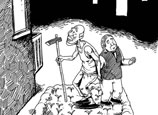
Key Words: Fed;U.S.;loose monetary;economy recovery;
Related Reading:
>> U.S. Fed's monetary policy serves as drag on economy: expert
>> U.S. economy expands modestly on holiday spending: Fed
WASHINGTON, Jan. 30 (Xinhua) -- U.S. Federal Reserve announced Wednesday to stick to the current ultra-loose monetary policy to support economic recovery, as the nation's economic activity came to a halt in recent months.
Information received since the Federal Open Market Committee ( FOMC) met in December suggests that "growth in economic activity paused in recent months," in large part because of weather-related disruptions and other transitory factors, the FOMC, the Fed's powerful interest rate setting panel, said in a statement.
U.S. real gross domestic product (GDP) declined 0.1 percent in the fourth quarter of 2012, the first time that U.S. economy has declined in about three years, U.S. Commerce Department said on Wednesday.
Employment has continued to expand at a moderate pace but the unemployment rate remains high. Household spending and business fixed investment have advanced, while the housing sector has shown further improvement, the FOMC said after wrapping up its two-day policy meeting.
To beef up U.S. economic growth, the central bank will continue purchasing additional agency mortgage-backed securities at a pace of 40 billion U.S. dollars per month and longer-term Treasury securities at a pace of 45 billion dollars per month, an ultra- loose monetary policy announced last month to expand the ongoing third round of quantitative easing program (QE3).
These moves were in an effort to put downward pressure on longer-term interest rates, support mortgage markets and boost lending activity, said the Fed.
Although strains in global financial markets have eased somewhat, the Fed continues to see downside risks to U.S. economic outlook, cautioned the central bank.
Since the onset of the financial crisis, the Fed has launched three rounds of quantitative easing programs, known as QE1, QE2 and QE3 and has thus far completed the first two rounds of the quantitative easing programs.
With QE1 and QE2, the Fed has bought more than 2 trillion dollars of Treasury securities and mortgage-backed securities, expanding its balance sheet to around 2.9 trillion U.S. dollars and attracting sharp criticism both at home and abroad.
The Fed on Wednesday decided to keep the target range for the federal funds rate at zero to 0.25 percent, and anticipates that this exceptionally low short-term rate will be appropriate as long as the unemployment rate remains above 6.5 percent and inflation is projected to be no more than 2.5 percent between one and two years ahead.
















 China uses PM 2.5 in weather alert system
China uses PM 2.5 in weather alert system


![]()
